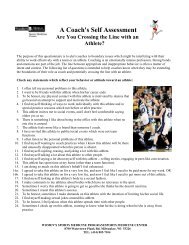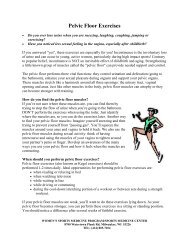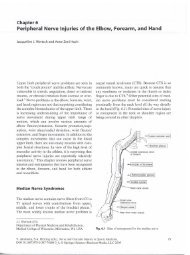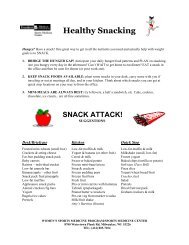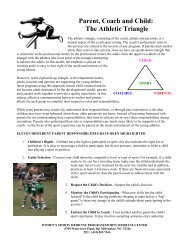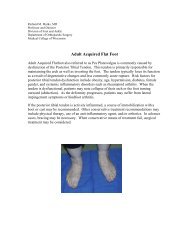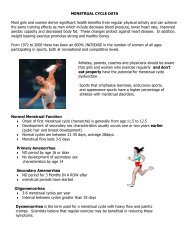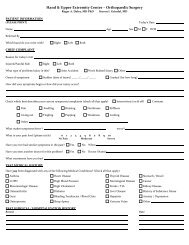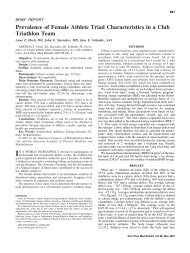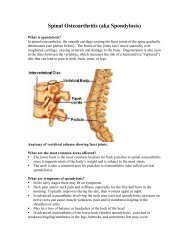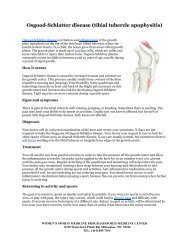Neck Pain, Cervical Radiculopathy, and Cervical Myelopathy
Neck Pain, Cervical Radiculopathy, and Cervical Myelopathy
Neck Pain, Cervical Radiculopathy, and Cervical Myelopathy
You also want an ePaper? Increase the reach of your titles
YUMPU automatically turns print PDFs into web optimized ePapers that Google loves.
This is an enhanced PDF from The Journal of Bone <strong>and</strong> Joint Surgery<br />
The PDF of the article you requested follows this cover page.<br />
<strong>Neck</strong> <strong>Pain</strong>, <strong>Cervical</strong> <strong>Radiculopathy</strong>, <strong>and</strong> <strong>Cervical</strong> <strong>Myelopathy</strong> :<br />
Pathophysiology, Natural History, <strong>and</strong> Clinical Evaluation<br />
Raj Rao<br />
J Bone Joint Surg Am. 84:1872-1881, 2002.<br />
This information is current as of March 27, 2006<br />
Reprints <strong>and</strong> Permissions<br />
Publisher Information<br />
Click here to order reprints or request permission to use material from this<br />
article, or locate the article citation on jbjs.org <strong>and</strong> click on the [Reprints <strong>and</strong><br />
Permissions] link.<br />
The Journal of Bone <strong>and</strong> Joint Surgery<br />
20 Pickering Street, Needham, MA 02492-3157<br />
www.jbjs.org<br />
Downloaded from www.ejbjs.org on March 27, 2006
1871<br />
Selected<br />
The American Academy of Orthopaedic Surgeons<br />
Printed with permission of the<br />
American Academy of<br />
Orthopaedic Surgeons. This article,<br />
as well as other lectures presented<br />
at the Academy’s Annual Meeting,<br />
will be available in March 2003 in<br />
Instructional Course Lectures,<br />
Volume 52. The complete<br />
volume can be ordered online<br />
at www.aaos.org, or by<br />
calling 800-626-6726<br />
(8 A.M.-5 P.M., Central time).<br />
DONALD C. FERLIC<br />
EDITOR, VOL. 52<br />
COMMITTEE<br />
DAVID L. HELFET<br />
CHAIRMAN<br />
JAMES H. BEATY<br />
DONALD C. FERLIC<br />
TERRY R. LIGHT<br />
VINCENT D. PELLEGRINI JR.<br />
EX-OFFICIO<br />
DEMPSEY S. SPRINGFIELD<br />
DEPUTY EDITOR OF THE JOURNAL OF BONE AND JOINT SURGERY<br />
FOR INSTRUCTIONAL COURSE LECTURES<br />
JAMES D. HECKMAN<br />
EDITOR-IN-CHIEF,<br />
THE JOURNAL OF BONE AND JOINT SURGERY<br />
Downloaded from www.ejbjs.org on March 27, 2006
1872<br />
THE JOURNAL OF BONE & JOINT SURGERY · JBJS.ORG<br />
VOLUME 84-A · NUMBER 10 · OCTOBER 2002<br />
NECK PAIN, CERVICAL RADICULOPATHY,<br />
AND CERVICAL MYELOPATHY<br />
<strong>Neck</strong> <strong>Pain</strong>, <strong>Cervical</strong><br />
<strong>Radiculopathy</strong>, <strong>and</strong><br />
<strong>Cervical</strong> <strong>Myelopathy</strong><br />
PATHOPHYSIOLOGY, NATURAL HISTORY, AND CLINICAL EVALUATION<br />
BY RAJ RAO, MD<br />
An Instructional Course Lecture, American Academy of Orthopaedic Surgeons<br />
<strong>Cervical</strong> spondylosis is a common <strong>and</strong><br />
occasionally disabling condition, occurring<br />
as a natural consequence of<br />
aging in the vast majority of the adult<br />
population. A clinical approach to<br />
symptomatic cervical spondylosis can<br />
be simplified by dividing the findings<br />
at presentation into the categories<br />
of axial neck pain, radiculopathy,<br />
myelopathy, or some combination<br />
of these three. While the pathogenesis<br />
of radiculopathy <strong>and</strong> myelopathy in<br />
cervical spondylosis is better understood,<br />
the source of neck pain remains<br />
controversial. The aim of this lecture is<br />
to review the pathophysiology <strong>and</strong><br />
natural history of each of these conditions<br />
<strong>and</strong> to describe the pertinent<br />
clinical features of cervical disc<br />
pathology.<br />
Pathophysiology<br />
<strong>Neck</strong> <strong>Pain</strong><br />
In a substantial number of patients,<br />
axial neck pain is a result of muscular<br />
or ligamentous factors related to posture,<br />
poor ergonomics, stress, <strong>and</strong>/or<br />
chronic muscle fatigue. <strong>Neck</strong> muscle<br />
pain can develop secondarily as a result<br />
of postural adaptations to a primary<br />
source of pain in the shoulder,<br />
the craniovertebral junction, or the<br />
temporom<strong>and</strong>ibular joint. The physiology<br />
of this pain process in the involved<br />
muscles is unclear. Patients<br />
with chronic myofascial pain have<br />
been shown to have a lower level of<br />
high-energy phosphates in the involved<br />
muscle tissue 1 . It is unclear<br />
whether this causes the pain or is a<br />
result of the pain. Unencapsulated free<br />
nerve endings in muscle serve as<br />
chemonociceptive <strong>and</strong> mechanonociceptive<br />
units. Chemonociceptive nerve<br />
endings may respond to metabolites<br />
that accumulate during anaerobic metabolism<br />
in fatigued muscle, or they<br />
may respond to non-neurogenic pain<br />
mediators released by injury or ischemia,<br />
such as bradykinin, histamine,<br />
serotonin, <strong>and</strong> potassium ions.<br />
Mechanonociceptive nerve endings respond<br />
to stretch or pressure. Sensitization<br />
of these nerve endings may be a<br />
primary source of muscle pain.<br />
Attributing axial neck pain to<br />
degenerative changes in the cervical<br />
discs or facet joints is a source of controversy,<br />
primarily because of the<br />
ubiquitous nature of such changes in<br />
the spine. Nevertheless, it does appear<br />
that cervical discs <strong>and</strong> facet joints can<br />
be pain generators. Nerve fibers <strong>and</strong><br />
nerve endings found in the peripheral<br />
portions of the disc 2,3 offer a possible<br />
mechanism by which degenerated cervical<br />
discs can produce pain directly.<br />
The disc is innervated by the sinuvertebral<br />
nerve, formed by branches from<br />
the ventral nerve root <strong>and</strong> the sympathetic<br />
plexus 3 (Fig. 1). Once formed,<br />
the nerve turns back into the intervertebral<br />
foramen along the posterior<br />
aspect of the disc, supplying portions<br />
of the annulus, the posterior longitudinal<br />
ligament, the periosteum of<br />
the vertebral body <strong>and</strong> pedicle, <strong>and</strong> the<br />
adjacent epidural veins. A recent review<br />
of the findings of cervical discography<br />
performed over a twelve-year<br />
period suggested that reliable patterns<br />
of pain are produced by stimulation<br />
of each cervical disc 4 (Fig. 2). The authors<br />
reported a high percentage of<br />
patients in whom multiple discs were<br />
concurrently responsible for axial<br />
neck pain.<br />
The facet joint is also recognized<br />
as a source of axial neck pain. Provocative<br />
injections into the facet joints in<br />
asymptomatic volunteers produce a<br />
reproducible pattern of axial neck<br />
pain <strong>and</strong> pain in the shoulder girdle 5<br />
Downloaded from www.ejbjs.org on March 27, 2006
1873<br />
THE JOURNAL OF BONE & JOINT SURGERY · JBJS.ORG<br />
VOLUME 84-A · NUMBER 10 · OCTOBER 2002<br />
NECK PAIN, CERVICAL RADICULOPATHY,<br />
AND CERVICAL MYELOPATHY<br />
Fig. 1<br />
Cross-sectional view showing the cervical nerve root, dorsal <strong>and</strong> ventral primary rami, recurrent<br />
meningeal or sinuvertebral nerve, <strong>and</strong> sympathetic plexus. Note the proximity of the disc space,<br />
vertebral artery, <strong>and</strong> facet joints. (Reprinted, with permission, from: Cramer GD, Darby SA,<br />
editors. Basic <strong>and</strong> clinical anatomy of the spine, spinal cord <strong>and</strong> ANS. St. Louis: Mosby Year-<br />
Book; 1995. p 141.)<br />
(Fig. 3). This pattern of facet-jointinduced<br />
pain can be accurately treated<br />
by anesthetic injections into the facet<br />
joint 6 , or by blocking the dorsal primary<br />
rami 7 , further suggesting that the facet<br />
joints do indeed play a role in the development<br />
of axial neck pain.<br />
Patients with degenerative arthritis<br />
in the upper cervical joints can<br />
present with severe suboccipital pain<br />
that radiates down into the neck or to<br />
the back of the ear. Injection of the atlantooccipital<br />
<strong>and</strong> atlantoaxial joints results<br />
in a reproducible pain pattern in<br />
this region 8 . Wächli et al. 9 reported unilateral<br />
headaches <strong>and</strong> atypical facial<br />
pain as a result of degenerative changes<br />
at the second <strong>and</strong> third cervical level. In<br />
some patients, suboccipital headaches<br />
are presumed to be a result of irritation<br />
of the greater occipital nerve, which<br />
originates from the posterior rami at<br />
the second, third, <strong>and</strong> fourth cervical<br />
levels. Another potential source of suboccipital<br />
pain is the sinuvertebral nerves<br />
from the first, second, <strong>and</strong> third cervical<br />
levels, which ascend cephalad to innervate<br />
the atlantoaxial ligaments, the tectorial<br />
membrane, <strong>and</strong> the dura mater of<br />
the upper cervical cord <strong>and</strong> posterior<br />
cranial fossa 3 .<br />
TABLE I Chemical Mediators of Spinal <strong>Pain</strong> 7<br />
Neurogenic<br />
Substance P<br />
Somatostatin<br />
Cholecystokinin-like substance<br />
Vasoactive intestinal peptide<br />
<strong>Cervical</strong> <strong>Radiculopathy</strong><br />
<strong>and</strong> <strong>Myelopathy</strong><br />
Neurologic symptoms in cervical<br />
spondylosis are the result of a cascade of<br />
degenerative changes that most likely<br />
begin at the cervical disc. Age-related<br />
changes in the chemical composition of<br />
the nucleus pulposus <strong>and</strong> annulus fibrosus<br />
result in a progressive loss of<br />
their viscoelastic properties. The disc<br />
loses height <strong>and</strong> bulges posteriorly into<br />
the canal. With this loss of height, the<br />
vertebral bodies drift toward one another.<br />
Posteriorly, there is infolding of<br />
the ligamentum flavum <strong>and</strong> facet joint<br />
capsule, causing a decrease in canal <strong>and</strong><br />
foraminal dimensions. Osteophytes<br />
form around the disc margins <strong>and</strong> at<br />
the uncovertebral <strong>and</strong> facet joints. The<br />
posteriorly protruded disc material, osteophytes,<br />
or thickened soft tissue<br />
within the canal or foramen results in<br />
extrinsic pressure on the nerve root or<br />
spinal cord.<br />
Mechanical distortion of the<br />
nerve root may lead to motor weakness<br />
or sensory deficits. The exact pathogenesis<br />
of radicular pain is unclear, but it is<br />
generally thought that, in addition to<br />
the compression, an inflammatory response<br />
of some kind is necessary for<br />
pain to develop. Within the compressed<br />
nerve root intrinsic blood vessels<br />
show increased permeability, which<br />
secondarily results in edema of the<br />
nerve root. Chronic edema <strong>and</strong> fibrosis<br />
within the nerve root can alter the re-<br />
Non-Neurogenic<br />
Bradykinin<br />
Serotonin<br />
Histamine<br />
Acetylcholine<br />
Calcitonin gene-related peptide Prostagl<strong>and</strong>in E 1<br />
Gastrin-releasing peptide Prostagl<strong>and</strong>in E 2<br />
Dynorphin<br />
Leukotrienes<br />
Enkephalin<br />
DiHETE<br />
Gelanin<br />
Neurotensin<br />
Angiotensin II<br />
Downloaded from www.ejbjs.org on March 27, 2006
1874<br />
THE JOURNAL OF BONE & JOINT SURGERY · JBJS.ORG<br />
VOLUME 84-A · NUMBER 10 · OCTOBER 2002<br />
NECK PAIN, CERVICAL RADICULOPATHY,<br />
AND CERVICAL MYELOPATHY<br />
Fig. 2<br />
Axial pain patterns provoked during discography<br />
at each cervical level. A = level<br />
between second <strong>and</strong> third cervical vertebrae,<br />
B = level between third <strong>and</strong> fourth<br />
cervical vertebrae, C = level between<br />
fourth <strong>and</strong> fifth cervical vertebrae, D =<br />
level between fifth <strong>and</strong> sixth cervical vertebrae,<br />
<strong>and</strong> E = level between sixth <strong>and</strong><br />
seventh cervical vertebrae. (Reprinted,<br />
with permission, from: Grubb SA, Kelly<br />
CK, Bogduk N. <strong>Cervical</strong> discography: clinical<br />
implications from 12 years of experience.<br />
Spine. 2000; 25:1382-9.)<br />
sponse threshold <strong>and</strong> increase the sensitivity<br />
of the nerve root to pain 10 .<br />
Neurogenic chemical mediators of pain<br />
released from the cell bodies of the<br />
sensory neurons <strong>and</strong> non-neurogenic<br />
mediators released from disc tissue may<br />
play a role in initiating <strong>and</strong> perpetuating<br />
this inflammatory response 11 (Table<br />
I). The dorsal root ganglion has been<br />
implicated in the pathogenesis of radicular<br />
pain. Prolonged discharges originate<br />
from the cell bodies of the dorsal<br />
root ganglion as a result of brief pressure.<br />
In addition to the chemicals produced<br />
by the cell bodies of the dorsal<br />
root ganglion, the membrane surrounding<br />
the dorsal root ganglion is<br />
more permeable than that around the<br />
nerve root, allowing a more florid local<br />
inflammatory response.<br />
Certain positions of the arm may<br />
decrease stress within the nerve root<br />
<strong>and</strong> relieve radicular pain. Davidson et<br />
al. described the shoulder abduction<br />
sign⎯i.e., relief of severe radicular pain<br />
when the patient rests the h<strong>and</strong> on the<br />
top of the head 12 . Davidson et al. theorized<br />
that, in addition to decreasing<br />
tension within the nerve root, this<br />
position may lift the sensory root or<br />
Fig. 3<br />
Composite map of axial pain patterns<br />
produced by injections into the facet<br />
joints at the second through seventh<br />
cervical levels. (Reprinted, with permission,<br />
from Dwyer A, Aprill C, Bogduk N.<br />
<strong>Cervical</strong> zygapophyseal joint pain patterns<br />
I: a study in normal volunteers.<br />
Spine. 1990;15:453-7.)<br />
dorsal root ganglion directly cephalad<br />
or lateral to the source of compression,<br />
<strong>and</strong> decompression of epidural veins<br />
may contribute to pain relief.<br />
Downloaded from www.ejbjs.org on March 27, 2006
1875<br />
THE JOURNAL OF BONE & JOINT SURGERY · JBJS.ORG<br />
VOLUME 84-A · NUMBER 10 · OCTOBER 2002<br />
NECK PAIN, CERVICAL RADICULOPATHY,<br />
AND CERVICAL MYELOPATHY<br />
Fig. 4<br />
Degenerative changes that contribute to compression of the<br />
spinal cord in cervical myelopathy. OPLL = ossification of the<br />
posterior longitudinal ligament. (Reprinted from: Bernhardt<br />
M, Hynes RA, Blume HW, White AA. Current concepts review:<br />
cervical spondylotic myelopathy. J Bone Joint Surg Am.<br />
1993;75:119-28.)<br />
<strong>Cervical</strong> spondylotic myelopathy<br />
is the manifestation of long-tract signs<br />
resulting from a decrease in the space<br />
available for the cervical spinal cord. In<br />
addition to the spondylotic processes<br />
that contribute to the extrinsic pressure<br />
(Fig. 4), certain factors are thought to<br />
be important in the development of<br />
myelopathy; these include the anteriorposterior<br />
diameter of the spinal canal,<br />
dynamic cord compression, dynamic<br />
changes in the intrinsic morphology of<br />
the spinal cord, <strong>and</strong> the vascular supply<br />
of the spinal cord.<br />
A congenital decrease in the<br />
anterior-posterior diameter of the<br />
spinal canal can play a role in the development<br />
of cervical myelopathy. The<br />
anterior-posterior diameter of the subaxial<br />
spine in normal adults measures<br />
17 to 18 mm, <strong>and</strong> the diameter of the<br />
spinal cord is approximately 10 mm in<br />
this region. Individuals with an anteriorposterior<br />
diameter of the spinal canal of<br />
1876<br />
THE JOURNAL OF BONE & JOINT SURGERY · JBJS.ORG<br />
VOLUME 84-A · NUMBER 10 · OCTOBER 2002<br />
NECK PAIN, CERVICAL RADICULOPATHY,<br />
AND CERVICAL MYELOPATHY<br />
Fig. 6<br />
Dynamic compression of the spinal cord with flexion <strong>and</strong> extension of the spinal column. (Reprinted<br />
from: Bernhardt M, Hynes RA, Blume HW, White AA. Current concepts review: cervical<br />
spondylotic myelopathy. J Bone Joint Surg Am. 1993;75:119-28.)<br />
the spinal column. Hypermobility<br />
cephalad to a degenerated <strong>and</strong> stiffened<br />
segment is commonly seen at the<br />
third <strong>and</strong> fourth cervical levels in<br />
elderly individuals, <strong>and</strong> it may result<br />
in myelopathy 18 .<br />
Morphologic changes also occur<br />
within the spinal cord itself with flexion<br />
<strong>and</strong> extension. Breig et al. showed<br />
that the spinal cord stretches with flexion<br />
of the cervical spine <strong>and</strong> shortens<br />
<strong>and</strong> thickens with extension 19 . Thickening<br />
of the cord in extension makes it<br />
more susceptible to pressure from the<br />
infolded ligamentum flavum or lamina.<br />
In flexion, the stretched cord may<br />
be prone to higher intrinsic pressure if<br />
it is abutting against a disc or a vertebral<br />
body anteriorly.<br />
In 1924, Barre was apparently the<br />
first to propose that vascular factors<br />
play a role in the development of cervical<br />
myelopathy 20 . Acute or subacute<br />
development of myelopathy in the absence<br />
of a mechanical compression of<br />
the spinal cord is thought to be pathognomonic<br />
in these patients 21 . There is<br />
some experimental evidence to support<br />
a role for vascular factors in the pathogenesis<br />
of myelopathy. <strong>Cervical</strong> cord ischemia<br />
superimposed on compression<br />
of the cord resulted in dramatic neurologic<br />
findings in two separate experiments<br />
involving canines 22,23 . The effects<br />
of compression <strong>and</strong> ischemia were<br />
thought to be additive <strong>and</strong> responsible<br />
for the clinical manifestation of myelopathy.<br />
In a separate study, obstruction<br />
of the peripial arterial plexus in<br />
dogs caused structural changes within<br />
the spinal cord 24 . The classic study by<br />
Breig et al. showed that blood flow<br />
through the anterior spinal artery <strong>and</strong><br />
anterior radicular arteries may be reduced<br />
when those vessels are tented<br />
over a disc or a vertebral body, but flow<br />
through the tortuous posterior spinal<br />
arteries is not substantially affected in<br />
this position 19 . Vessels that are thought<br />
to be most prone to reduced flow are<br />
the transverse intramedullary arterioles<br />
arising from the anterior sulcal arteries.<br />
These vessels perfuse the gray matter<br />
<strong>and</strong> adjacent lateral columns 25 .<br />
Severe compression results in degenerative<br />
changes in the spinal cord.<br />
The central gray matter <strong>and</strong> the lateral<br />
columns show the most changes, with<br />
cystic cavitation, gliosis, <strong>and</strong> demyelination<br />
most prominent caudad to the<br />
site of compression. The posterior columns<br />
<strong>and</strong> posterolateral tracts show<br />
wallerian degeneration cephalad to the<br />
site of compression. These irreversible<br />
changes may explain why some patients<br />
do not recover following decompressive<br />
surgery.<br />
Natural History<br />
There are few population-based studies<br />
on the prevalence of neck pain. A recent<br />
study of a Saskatchewan adult population<br />
showed that neck pain is more<br />
prevalent than commonly perceived:<br />
66% of adults experienced neck pain<br />
during their lifetime, with 54% having<br />
experienced it during the past six<br />
months <strong>and</strong> 5% highly disabled by it 26 .<br />
Another population study demonstrated<br />
a 9% point prevalence of neck<br />
<strong>and</strong> shoulder pain 27 . The prevalence of<br />
neck pain appears to be higher in better<br />
educated individuals with a history of<br />
injury, headaches, or low-back pain 28 .<br />
DePalma et al. found that most<br />
patients with axial symptoms from cervical<br />
spondylosis do reasonably well 29 .<br />
They reported that, following three<br />
months of nonoperative care, 21% of<br />
patients had complete relief of symptoms,<br />
49% had partial relief, <strong>and</strong> 22%<br />
had no relief. Rothman <strong>and</strong> Rashbaum<br />
found that 23% of a similar group of<br />
patients remained partially or totally<br />
disabled at the end of five years 30 . In the<br />
same study, they found no substantial<br />
difference between that group of<br />
nonoperatively treated patients <strong>and</strong><br />
another group of patients with “predominantly”<br />
axial neck pain who had<br />
undergone surgery. They recommended<br />
nonoperative management for axial<br />
symptoms.<br />
In 1963, Lees <strong>and</strong> Turner reported<br />
on the natural history <strong>and</strong> prognosis<br />
of cervical spondylosis 31 . Fifty-one<br />
patients in their “non-myelopathic<br />
group” had pain in the neck, shoulders,<br />
arms, or h<strong>and</strong>s. Patients were treated<br />
with a collar, exercises, traction, manipulation,<br />
<strong>and</strong> rest. Of ten patients who<br />
were followed for ten to nineteen years,<br />
three had no symptoms after the first<br />
few months of treatment, three continued<br />
to have mild symptoms, <strong>and</strong> four<br />
had more troublesome symptoms. Of<br />
forty-one patients who were followed<br />
for two to ten years, nineteen had no<br />
symptoms, twelve had intermittent<br />
symptoms, <strong>and</strong> ten had moderate disability.<br />
Myelopathic symptoms did not<br />
develop in any of the patients during the<br />
course of the nineteen-year follow-up<br />
period. It appears that, while approximately<br />
45% of patients with nonmyelopathic<br />
symptoms have good resolution<br />
of those symptoms shortly after<br />
onset, the remaining 55% continue to<br />
have minor or moderate long-term<br />
morbidity. Nonoperative treatment appeared<br />
to alleviate symptoms without<br />
influencing the eventual outcome.<br />
Gore et al. carried out a clinical<br />
<strong>and</strong> radiographic study of 205 patients<br />
who had presented with axial neck pain<br />
or radicular symptoms in the upper<br />
extremities 32 . One hundred <strong>and</strong> sixtyone<br />
of these patients were treated with<br />
Downloaded from www.ejbjs.org on March 27, 2006
1877<br />
THE JOURNAL OF BONE & JOINT SURGERY · JBJS.ORG<br />
VOLUME 84-A · NUMBER 10 · OCTOBER 2002<br />
NECK PAIN, CERVICAL RADICULOPATHY,<br />
AND CERVICAL MYELOPATHY<br />
rest, traction, a collar, medications, or<br />
combinations of these modalities. At the<br />
time of follow-up at ten to twenty-five<br />
years, 43% had complete resolution of<br />
pain, 25% had mild residual pain, <strong>and</strong><br />
32% had moderate or severe residual<br />
pain. Patients with radicular symptoms<br />
or findings had a less favorable prognosis.<br />
Treatment did not appear to influence<br />
the eventual outcome. The pain<br />
could not be correlated to the degenerative<br />
changes seen on radiographs. Gore<br />
et al. concluded that many patients with<br />
this condition have long-term symptoms<br />
that may be moderately disabling.<br />
The true natural history of cervical<br />
myelopathy may be difficult to determine<br />
because in the vast majority of<br />
cases the symptoms are attributed to<br />
age or other neurologic conditions.<br />
Thus, knowledge of the natural history<br />
of this condition has been derived from<br />
a select population in whom the disease<br />
was already diagnosed <strong>and</strong> possibly<br />
was well established. In 1952, Spillane<br />
<strong>and</strong> Lloyd reported that the course of<br />
cervical myelopathy in their patients<br />
appeared to be one of progressive<br />
disability 33 . In a 1956 report on 120 patients<br />
with cervical spondylotic myelopathy,<br />
Clarke <strong>and</strong> Robinson stated their<br />
belief that, once the disorder was recognized,<br />
neurologic function never returned<br />
to normal 34 . Of their patients,<br />
75% had episodic progression, 20%<br />
showed slow steady progression, <strong>and</strong><br />
5% had a rapid onset of symptoms followed<br />
by a lengthy period of stability.<br />
Sensory <strong>and</strong> bladder changes tended to<br />
be transient, but motor changes tended<br />
to persist <strong>and</strong> to progress over time. A<br />
soft collar helped to decrease nerve-root<br />
symptoms <strong>and</strong> improve gait for 50% of<br />
their patients.<br />
Lees <strong>and</strong> Turner reported on a<br />
group of forty-four patients who had<br />
had symptoms of myelopathy for three<br />
to forty years 31 . They thought that long<br />
periods of nonprogressive disability<br />
were the rule <strong>and</strong> progressive deterioration<br />
was the exception. Neither the age<br />
at the onset of symptoms nor treatment<br />
with a collar or surgery appeared<br />
to influence the eventual prognosis.<br />
Nurick reported similar findings: he observed<br />
that the disability was established<br />
early in the course of the disease<br />
<strong>and</strong> was followed by static periods lasting<br />
many years 35 . The prognosis was<br />
better for patients who presented with<br />
mild disease, <strong>and</strong> disability tended to<br />
progress in patients older than sixty<br />
years of age. Symon <strong>and</strong> Lavender 36 reviewed<br />
the results reported by Lees <strong>and</strong><br />
Turner <strong>and</strong> found that, when disability<br />
was used as a criterion, only 18% of patients<br />
showed improvement. In their<br />
own series, they reported steady, progressive<br />
deterioration in 67% of patients<br />
with cervical spondylotic<br />
myelopathy. Phillips also thought that<br />
the prognosis was poor; only one-third<br />
of his patients obtained improvement<br />
from treatment with a soft collar, <strong>and</strong><br />
patients who had had symptoms for<br />
more than two years showed no<br />
improvement 37 . A recent multicenter,<br />
nonr<strong>and</strong>omized study by the <strong>Cervical</strong><br />
Spine Research Society suggested a similarly<br />
poor outcome of nonsurgical<br />
management of cervical myelopathy 38 .<br />
In that study of forty-three patients,<br />
twenty underwent surgery <strong>and</strong> twentythree<br />
received medical treatment. The<br />
surgically treated patients had decreased<br />
neurologic symptoms <strong>and</strong> overall<br />
pain <strong>and</strong> improved functional status,<br />
but the nonsurgically treated patients<br />
had a decrease in their ability to perform<br />
activities of daily living with worsening<br />
of neurologic symptoms.<br />
Clinical Evaluation<br />
Axial <strong>Neck</strong> <strong>Pain</strong><br />
<strong>Neck</strong> pain is an extremely common but<br />
nonspecific presenting symptom. The<br />
pain or soreness is usually in the paramedian<br />
neck muscles posteriorly, with<br />
radiation toward the occiput or into<br />
the shoulder <strong>and</strong> periscapular regions.<br />
The patient reports stiffness in one or<br />
more directions, <strong>and</strong> headaches are<br />
common 39 . The neck pain may be accompanied<br />
by radiating “referred” pain<br />
in the shoulder or arm that does not<br />
follow a dermatomal distribution. Referred<br />
pain can be associated with a<br />
sensation of warmth or tingling <strong>and</strong><br />
with autonomic phenomena such as piloerection<br />
<strong>and</strong> sweating. Localized areas<br />
of tenderness in the muscle may be<br />
present. Deep palpation of some of<br />
these areas, known as trigger points, results<br />
in reproducible patterns of referred<br />
pain.<br />
In the absence of radicular symptoms<br />
or findings, determining the<br />
source of neck pain can be a diagnostic<br />
challenge. Identifying a position of<br />
maximal discomfort may provide a clue<br />
to the underlying pathology. Anterior<br />
neck pain along the sternocleidomastoid<br />
muscle belly that is aggravated by<br />
rotation to the contralateral side is most<br />
often a result of muscular strain. <strong>Pain</strong> in<br />
the posterior neck muscles that is worsened<br />
by flexion of the head suggests a<br />
myofascial etiology. <strong>Pain</strong> in the posterior<br />
aspect of the neck that is aggravated<br />
by extension, especially with rotation of<br />
the head to one side, suggests the possibility<br />
of a discogenic component. Patients<br />
who present with severe pain in<br />
the suboccipital region often have<br />
pathological changes in the upper cervical<br />
spine. The pain in these patients<br />
may radiate to the back of the ear or the<br />
caudad part of the neck. Rotation of the<br />
neck is often markedly restricted.<br />
<strong>Pain</strong> in the neck <strong>and</strong> shoulder girdle<br />
can develop as a result of adaptations<br />
stemming from an initial source<br />
of pain. The initial source of pain may<br />
resolve, but postural adaptations <strong>and</strong><br />
compensatory overuse of normal tissues<br />
in the neck <strong>and</strong> shoulder girdle can<br />
result in new pain patterns. It is important<br />
to obtain an accurate history regarding<br />
how the pain initially presented<br />
<strong>and</strong> how it might have changed with<br />
time.<br />
Pathological changes in the<br />
shoulder can present with localized<br />
pain or pain referred to the neck. The<br />
pain may radiate down the anterior or<br />
lateral aspect of the arm. Careful examination<br />
of the shoulder will help to differentiate<br />
this cause from pathological<br />
changes in the neck. <strong>Pain</strong> in the neck<br />
<strong>and</strong> shoulder girdle can also be referred<br />
from the heart, lungs, viscera, <strong>and</strong> temporom<strong>and</strong>ibular<br />
joint. A detailed <strong>and</strong><br />
accurate history <strong>and</strong> examination will<br />
help to rule out the possibility that pain<br />
in the neck is being referred from another<br />
region. Morning stiffness, polyarticular<br />
involvement, rigidity, or<br />
cutaneous manifestations suggest an in-<br />
Downloaded from www.ejbjs.org on March 27, 2006
1878<br />
THE JOURNAL OF BONE & JOINT SURGERY · JBJS.ORG<br />
VOLUME 84-A · NUMBER 10 · OCTOBER 2002<br />
NECK PAIN, CERVICAL RADICULOPATHY,<br />
AND CERVICAL MYELOPATHY<br />
flammatory arthritic component. Fever,<br />
weight loss, or nonmechanical neck<br />
pain may point to an infectious or neoplastic<br />
process.<br />
<strong>Cervical</strong> <strong>Radiculopathy</strong><br />
<strong>Cervical</strong> radiculopathy refers to symptoms<br />
in a specific dermatomal distribution<br />
in the upper extremity. Patients<br />
describe sharp pain <strong>and</strong> tingling or<br />
burning sensations in the involved area.<br />
There may be sensory or motor loss corresponding<br />
to the involved nerve root,<br />
<strong>and</strong> reflex activity may be diminished.<br />
Patients typically have severe neck<br />
<strong>and</strong> arm pain that prevents them from<br />
getting into a comfortable position.<br />
They may hold the arm over the head,<br />
typically resting the wrist or forearm on<br />
top of the head (the shoulder abduction<br />
sign 12 ) <strong>and</strong> sometimes tilting the head<br />
to the contralateral side. The symptoms<br />
are usually aggravated by extension or<br />
lateral rotation of the head to the side of<br />
the pain (the Spurling maneuver). Aggravation<br />
of the symptoms by neck extension<br />
often helps to differentiate a<br />
radicular etiology from muscular neck<br />
pain or a pathological condition of the<br />
shoulder with secondary muscle pain in<br />
the neck. It is also important to remember<br />
that multiple sources of pain in the<br />
neck <strong>and</strong> upper extremity are common<br />
<strong>and</strong> that the nerve structures may be<br />
compressed at more than one site 40,41 .<br />
Patients with metabolic disorders, such<br />
as diabetes, who have neuropathy may<br />
be more susceptible to radiculopathy<br />
<strong>and</strong> compressive neuropathy. Adaptations<br />
to the initial radiculopathy may<br />
result in secondary pathological<br />
changes in the shoulder, carpal tunnel<br />
syndrome, or ulnar nerve irritation,<br />
which may persist long after the initial<br />
radiculopathy has resolved. Henderson<br />
et al. reviewed the clinical presentations<br />
of cervical radiculopathy in 736<br />
patients 42 : 99.4% had arm pain, 85.2%<br />
had sensory deficits, 79.7% had neck<br />
pain, 71.2% had reflex deficits, 68% had<br />
motor deficits, 52.5% had scapular<br />
pain, 17.8% had anterior chest pain,<br />
9.7% had headaches, 5.9% had anterior<br />
chest <strong>and</strong> arm pain, <strong>and</strong> 1.3% had<br />
left-sided chest <strong>and</strong> arm pain (cervical<br />
angina). Neurologic deficits corresponded<br />
with the offending disc level in<br />
approximately 80% of patients.<br />
<strong>Radiculopathy</strong> of the third cervical<br />
nerve root results from pathological<br />
changes in the disc between the second<br />
<strong>and</strong> third cervical levels <strong>and</strong> is unusual.<br />
The posterior ramus of the third cervical<br />
nerve innervates the suboccipital region,<br />
<strong>and</strong> involvement of that nerve<br />
causes pain in this region, often extending<br />
to the back of the ear. An isolated<br />
motor deficit from radiculopathy of the<br />
third cervical nerve root cannot be detected<br />
clinically.<br />
<strong>Radiculopathy</strong> of the fourth cervical<br />
nerve root may be an unexplained<br />
cause of neck <strong>and</strong> shoulder pain.<br />
Numbness extending from the caudad<br />
aspect of the neck to the superior aspect<br />
of the shoulder may be present. Diaphragmatic<br />
involvement may result<br />
from involvement of the third, fourth,<br />
<strong>and</strong> fifth cervical nerve roots 43,44 . Motor<br />
deficits in the diaphragm manifest as<br />
paradoxical respiration, <strong>and</strong> they may<br />
be confirmed by fluoroscopic evaluation<br />
of the abdomen.<br />
<strong>Radiculopathy</strong> of the fifth cervical<br />
nerve root can present with numbness<br />
in an “epaulet” distribution, beginning<br />
at the superior aspect of the shoulder<br />
<strong>and</strong> extending laterally to the midpart<br />
of the arm. The deltoid muscle is innervated<br />
primarily by the fifth cervical<br />
nerve, <strong>and</strong> involvement of that nerve<br />
can result in profound weakness of this<br />
muscle. The absence of pain with a<br />
range of motion of the shoulder <strong>and</strong> the<br />
absence of impingement signs at the<br />
shoulder help to differentiate radiculopathy<br />
of the fifth cervical nerve root<br />
from a pathological shoulder condition.<br />
The biceps reflex is innervated by the<br />
fifth <strong>and</strong> sixth cervical nerves <strong>and</strong> may<br />
be affected.<br />
<strong>Radiculopathy</strong> of the sixth cervical<br />
nerve root presents with pain radiating<br />
from the neck to the lateral aspect of the<br />
biceps, to the lateral aspect of the forearm,<br />
to the dorsal aspect of the web space<br />
between the thumb <strong>and</strong> index finger, <strong>and</strong><br />
into the tips of those digits. Numbness<br />
occurs in the same distribution. Motor<br />
deficits are best elicited in the wrist extensors,<br />
but they also may be elicited by<br />
elbow flexion <strong>and</strong> forearm supination.<br />
The brachioradialis <strong>and</strong> biceps reflexes<br />
may be lost or diminished. The sensory<br />
symptoms may mimic carpal tunnel syndrome,<br />
which typically involves the radial<br />
three <strong>and</strong> a half digits <strong>and</strong> causes<br />
weakness in the thenar musculature.<br />
The seventh cervical nerve root is<br />
the most frequently involved by cervical<br />
radiculopathy. The patient has pain<br />
radiating along the back of the shoulder,<br />
often extending into the scapular<br />
region, down along the triceps, <strong>and</strong><br />
then along the dorsum of the forearm<br />
<strong>and</strong> into the dorsum of the long finger.<br />
The patient usually pronates the forearm<br />
while trying to describe the location<br />
of the symptoms, <strong>and</strong> this is a<br />
useful observation when the physician<br />
is trying to differentiate the h<strong>and</strong> symptoms<br />
from those of sixth cervical radiculopathy<br />
<strong>and</strong> carpal tunnel syndrome.<br />
Motor weakness is best appreciated in<br />
the triceps, wrist flexors, <strong>and</strong> finger extensors.<br />
The triceps reflex may be lost<br />
or diminished. Entrapment of the posterior<br />
interosseus nerve may be mistaken<br />
for the motor component of<br />
seventh cervical radiculopathy <strong>and</strong> presents<br />
with weakness in the extensor digitorum<br />
communis, extensor pollicis<br />
longus, <strong>and</strong> extensor carpi ulnaris. Sensory<br />
changes are absent, however, <strong>and</strong><br />
the triceps <strong>and</strong> wrist flexors show normal<br />
strength.<br />
<strong>Radiculopathy</strong> of the eighth cervical<br />
nerve root usually presents with<br />
symptoms extending down the medial<br />
aspect of the arm <strong>and</strong> forearm <strong>and</strong> into<br />
the medial border of the h<strong>and</strong> <strong>and</strong> the<br />
ulnar two digits. Numbness usually involves<br />
the dorsal <strong>and</strong> volar aspects of<br />
the ulnar two digits <strong>and</strong> h<strong>and</strong> <strong>and</strong> may<br />
extend up the medial aspect of the<br />
forearm. The patient reports difficulty<br />
with using the h<strong>and</strong>s for routine daily<br />
activities. It is important to differentiate<br />
eighth cervical radiculopathy from<br />
ulnar nerve weakness. The function of<br />
the flexor digitorum profundus in the<br />
index <strong>and</strong> long fingers <strong>and</strong> of the flexor<br />
pollicis longus in the thumb can be affected<br />
by eighth cervical radiculopathy,<br />
but they are not affected by ulnar<br />
nerve entrapment. With the exception<br />
of the adductor pollicis, the short thenar<br />
muscles are spared with ulnar<br />
Downloaded from www.ejbjs.org on March 27, 2006
1879<br />
THE JOURNAL OF BONE & JOINT SURGERY · JBJS.ORG<br />
VOLUME 84-A · NUMBER 10 · OCTOBER 2002<br />
NECK PAIN, CERVICAL RADICULOPATHY,<br />
AND CERVICAL MYELOPATHY<br />
TABLE II Differential Diagnosis of<br />
<strong>Radiculopathy</strong><br />
Peripheral entrapment syndromes<br />
Rotator cuff/shoulder pathology<br />
Brachial plexitis<br />
Herpes zoster<br />
Thoracic outlet syndrome<br />
Sympathetic mediated pain syndrome<br />
Intraspinal or extraspinal tumor<br />
Epidural abscess<br />
Cardiac ischemia<br />
nerve involvement but involved with<br />
eighth cervical or first thoracic radiculopathy.<br />
Entrapment of the anterior<br />
interosseus nerve may masquerade<br />
as eighth cervical or first thoracic radiculopathy,<br />
but it does not cause<br />
the sensory changes or have thenar<br />
muscle involvement.<br />
Patients occasionally present with<br />
symptoms that simulate radiculopathy<br />
but result from nonspondylotic pathological<br />
changes (Table II). Schwannomas<br />
usually arise from the intradural<br />
portion of the sensory root <strong>and</strong> may<br />
cause severe pain in a dermatomal distribution.<br />
Meningiomas can similarly<br />
cause radicular or myelopathic symptoms,<br />
depending on their size <strong>and</strong> precise<br />
location. Benign or malignant<br />
vertebral body tumors usually present<br />
with nonmechanical neck pain that<br />
progresses to severe radiculopathy, <strong>and</strong><br />
even myelopathy, as the amount of<br />
bone destruction increases. A Pancoast<br />
tumor of the apical lung can involve the<br />
caudad cervical nerve roots <strong>and</strong>, additionally,<br />
involve the sympathetic chain.<br />
Idiopathic brachial plexus neuritis is<br />
thought to be viral in nature <strong>and</strong> presents<br />
with severe arm pain that resolves<br />
<strong>and</strong> leaves behind polyradicular motor<br />
deficits. Polyradicular involvement may<br />
also be seen with epidural abscesses. Reflex<br />
sympathetic dystrophy occasionally<br />
occurs following trauma to the<br />
upper extremity, <strong>and</strong> it presents as diffuse<br />
burning pain or paresthesias accompanied<br />
by discoloration, edema, or<br />
other autonomic phenomena.<br />
<strong>Cervical</strong> Spondylotic <strong>Myelopathy</strong><br />
<strong>Cervical</strong> spondylotic myelopathy is the<br />
most common cause of acquired spastic<br />
paraparesis in adults. The patient<br />
may present with subtle findings that<br />
have been present for years or with<br />
quadriparesis that developed over the<br />
course of a few hours. Perhaps the most<br />
unique feature of the condition is its<br />
subtle <strong>and</strong> varied presentation, <strong>and</strong> the<br />
fact that its diagnosis requires a high index<br />
of suspicion.<br />
The clinical picture varies, depending<br />
on the anatomic portion of the<br />
cord that is primarily involved. Cr<strong>and</strong>all<br />
<strong>and</strong> Batzdorf described five broad categories<br />
of cervical spondylotic myelopathy<br />
45 : (1) transverse lesion syndrome, in<br />
which the corticospinal, spinothalamic,<br />
<strong>and</strong> posterior cord tracts were involved<br />
with almost equal severity <strong>and</strong> which<br />
was associated with the longest duration<br />
of symptoms, suggesting that this category<br />
may be an end stage of the disease;<br />
(2) motor system syndrome, in which<br />
corticospinal tracts <strong>and</strong> anterior horn<br />
cells were involved, resulting in spasticity;<br />
(3) central cord syndrome, in which<br />
motor <strong>and</strong> sensory deficits affected the<br />
upper extremities more severely than the<br />
lower extremities; (4) Brown-Séquard<br />
syndrome, which consisted of ipsilateral<br />
motor deficits with contralateral sensory<br />
deficits <strong>and</strong> which appeared to be the<br />
least advanced form of the disease, <strong>and</strong><br />
(5) brachialgia <strong>and</strong> cord syndrome,<br />
which consisted of radicular pain in the<br />
upper extremity along with motor <strong>and</strong>/<br />
or sensory long-tract signs.<br />
Ferguson <strong>and</strong> Caplan divided cervical<br />
spondylotic myelopathy into four<br />
syndromes 21 : (1) medial syndrome, consisting<br />
primarily of long-tract symptoms;<br />
(2) lateral syndrome, consisting<br />
primarily of radicular symptoms; combined<br />
medial <strong>and</strong> lateral syndrome,<br />
which is the most common clinical presentation;<br />
<strong>and</strong> (4) vascular syndrome,<br />
which presents with a rapidly progressive<br />
myelopathy <strong>and</strong> is thought to represent<br />
vascular insufficiency of the<br />
cervical spinal cord.<br />
The findings in cervical spondylotic<br />
myelopathy vary from patient to<br />
patient. Patients typically present with<br />
the insidious onset of clumsiness in the<br />
h<strong>and</strong>s <strong>and</strong> lower limbs. They may report<br />
worsening h<strong>and</strong>writing in the past<br />
few months or weeks, difficulty with<br />
grasping <strong>and</strong> holding, or diffuse numbness<br />
in the h<strong>and</strong>s. They frequently have<br />
had increasing difficulty with balance<br />
that they attribute to age or arthritic<br />
hips, <strong>and</strong> relatives may volunteer that<br />
their gait has become increasingly<br />
awkward. Nurick developed a system<br />
for grading the disability in cervical<br />
spondylotic myelopathy on the basis of<br />
gait abnormality 35 (Table III). On physical<br />
examination, the findings that establish<br />
the diagnosis are brisk reflexes,<br />
clonus, or pathological reflexes confirming<br />
an upper-motor-neuron lesion.<br />
<strong>Myelopathy</strong> resulting from a<br />
region of the cord cephalad to the third<br />
cervical level may result in a hyperactive<br />
scapulohumeral reflex 46 ⎯i.e., tapping<br />
of the spine of the scapula or acromion<br />
results in scapular elevation <strong>and</strong>/or abduction<br />
of the humerus. This is thought<br />
to be a stretch reflex of the trapezius<br />
muscle. Superficial reflexes such as the<br />
abdominal or cremasteric reflex are often<br />
diminished or absent in the presence<br />
of upper-motor-neuron lesions.<br />
The pathological reflexes that are typically<br />
elicited are the inverted radial reflex,<br />
the Hoffmann reflex, <strong>and</strong> the<br />
extensor plantar reflex. Muscle weakness<br />
<strong>and</strong> wasting in the lower extremi-<br />
TABLE III Nurick 35<br />
Classification of Disability from <strong>Cervical</strong> <strong>Myelopathy</strong><br />
Grade I<br />
Grade II<br />
Grade III<br />
Grade IV<br />
Grade V<br />
No difficulty in walking<br />
Mild gait involvement not interfering with employment<br />
Gait abnormality preventing employment<br />
Able to walk only with assistance<br />
Chairbound or bedridden<br />
Downloaded from www.ejbjs.org on March 27, 2006
1880<br />
THE JOURNAL OF BONE & JOINT SURGERY · JBJS.ORG<br />
VOLUME 84-A · NUMBER 10 · OCTOBER 2002<br />
NECK PAIN, CERVICAL RADICULOPATHY,<br />
AND CERVICAL MYELOPATHY<br />
TABLE IV Differential Diagnoses<br />
of <strong>Cervical</strong> Spondylotic<br />
<strong>Myelopathy</strong><br />
Peripheral polyneuropathy<br />
Motor neuron disease<br />
Multiple sclerosis<br />
Cerebrovascular disease<br />
Syringomyelia<br />
ties with superimposed loss of<br />
proprioception result in an unsteady,<br />
broad-based gait.<br />
Sensory findings in cervical<br />
spondylotic myelopathy vary. <strong>Pain</strong>,<br />
temperature, proprioception, vibratory,<br />
<strong>and</strong> dermatomal sensations may<br />
all be diminished, depending on the exact<br />
area of the cord or the nerve-root<br />
that is compromised. Sphincter disturbances<br />
are not usually presenting symptoms.<br />
Patients may complain of urinary<br />
urgency, hesitation, <strong>and</strong> frequency <strong>and</strong><br />
rarely of urinary incontinence or retention.<br />
Fecal incontinence is unusual. In a<br />
study of sixty-two patients with cervical<br />
spondylotic myelopathy by Cr<strong>and</strong>all<br />
<strong>and</strong> Batzdorf 45 , neck pain was present in<br />
fewer than half of the patients <strong>and</strong> associated<br />
radicular pain was present in<br />
38%. The Lhermitte sign with shocklike<br />
sensations in the torso <strong>and</strong> limbs<br />
resulting from quick flexion or extension<br />
of the neck was present in 27% of<br />
the patients, <strong>and</strong> sphincter disturbances<br />
were present in 44%.<br />
H<strong>and</strong> dysfunction in cervical<br />
spondylosis has, in the past, been attributed<br />
primarily to radicular pathology.<br />
Several recent reports have shown<br />
findings specific to the “myelopathy<br />
h<strong>and</strong>.” 47,48 Diffuse numbness in the<br />
h<strong>and</strong>s is extremely common <strong>and</strong> is<br />
often misdiagnosed as peripheral neuropathy<br />
or carpal tunnel syndrome.<br />
Clumsiness of the h<strong>and</strong>s results in an<br />
inability to carry out fine motor tasks.<br />
Marked wasting of the intrinsic h<strong>and</strong><br />
muscles is usually present 49 . Ono et al. 47<br />
described two specific signs of myelopathy<br />
h<strong>and</strong>: (1) the finger-escape sign<br />
(when the patient is asked to fully extend<br />
the digits with the palm facing<br />
down, the ulnar digits tend to drift into<br />
abduction <strong>and</strong> flexion) <strong>and</strong> (2) the<br />
grip-<strong>and</strong>-release test (weakness <strong>and</strong><br />
spasticity of the h<strong>and</strong> result in a decreased<br />
ability to rapidly open <strong>and</strong> close<br />
the fist). Many neurologic conditions<br />
can mimic cervical spondylotic myelopathy<br />
(Table IV). Multiple sclerosis, a demyelinating<br />
disorder of the central<br />
nervous system, causes both motor <strong>and</strong><br />
sensory symptoms, but it typically has<br />
remissions <strong>and</strong> exacerbations, involvement<br />
of the cranial nerves, <strong>and</strong> characteristic<br />
plaques that can be seen on<br />
magnetic resonance imaging of the<br />
brain <strong>and</strong> spinal cord. Amyotrophic lateral<br />
sclerosis results in upper <strong>and</strong> lower<br />
motor-neuron symptoms, with no alteration<br />
in sensation. Subacute combined<br />
degeneration seen with vitamin-<br />
B12 deficiency results in corticospinal<br />
tract <strong>and</strong> posterior tract symptoms,<br />
with greater sensory involvement in the<br />
lower extremities. Patients with metabolic<br />
or idiopathic peripheral neuropathy<br />
have sensory symptoms that mimic<br />
those of myelopathy.<br />
Atypical Presentations<br />
of <strong>Cervical</strong> Spondylosis<br />
<strong>Cervical</strong> angina, a symptom constellation<br />
mimicking ischemic heart disease<br />
but produced by cervical radiculopathy,<br />
is a well-known entity. Women<br />
with pain of cervical radicular origin<br />
may present with chronic breast pain 50 .<br />
Facial pain or paresthesias may be secondary<br />
to involvement of the spinal nucleus<br />
of the trigeminal nerve <strong>and</strong> may<br />
result from pressure on the cephalad<br />
<strong>and</strong> middle parts of the cervical spinal<br />
cord. Marked spurring along the anterior<br />
aspects of the vertebral bodies as a<br />
result of proliferative degenerative<br />
changes may manifest as dysphagia,<br />
dyspnea, or dysphonia as a result of<br />
pressure on the esophagus, larynx, or<br />
trachea. Similar hypertrophic spurs resulting<br />
from the uncovertebral joints<br />
<strong>and</strong> facet joints can occlude the vertebral<br />
artery in its foramen <strong>and</strong> result in<br />
thrombosis of the vertebral artery. If the<br />
thrombosis spreads to the posterior inferior<br />
cerebellar artery, it may lead to<br />
palsy of the ipsilateral V, IX, X, <strong>and</strong> XI<br />
cranial nerves, Horner syndrome, cerebellar<br />
ataxia, <strong>and</strong> possibly death⎯a<br />
constellation known as Wallenberg syndrome.<br />
Sympathetic chain involvement<br />
can result in atypical symptoms such as<br />
dizziness, blurring of vision, tinnitus,<br />
retroocular pain, facial pain, or jaw<br />
pain 51 . <strong>Cervical</strong> spondylotic myelopathy<br />
has also been reported to present<br />
with hemiparesis 52 .<br />
<strong>Radiculopathy</strong> occasionally presents<br />
in association with myelopathy.<br />
It is important not to let overriding<br />
radicular deficits obscure an underlying<br />
myelopathy. Patients with cervical<br />
myelopathy occasionally may have concomitant<br />
peripheral neuropathy or<br />
lumbar stenosis 53 , which might mask<br />
the lower-extremity hyperreflexia typically<br />
expected from the myelopathy.<br />
Overview<br />
Degenerative cervical disc disease is a<br />
common condition that is, for the most<br />
part, asymptomatic. When symptoms do<br />
develop, they can be easily grouped into<br />
axial neck pain, radiculopathy, <strong>and</strong> myelopathy.<br />
An underst<strong>and</strong>ing of the pathophysiology<br />
of these conditions makes it<br />
possible to determine clinically whether<br />
the symptoms are likely a result of cervical<br />
spinal pathology <strong>and</strong>, in many cases,<br />
to further localize a specific level within<br />
the neck. The natural history of these<br />
conditions suggests that patients with<br />
axial symptoms usually are best treated<br />
without surgery, although some patients<br />
with radiculopathy continue to be disabled<br />
by pain <strong>and</strong> may be c<strong>and</strong>idates for<br />
operative treatment. Patients with myelopathy<br />
are unlikely to have substantial<br />
improvement <strong>and</strong>, in most cases, show<br />
stepwise deterioration. Surgical decompression<br />
<strong>and</strong> stabilization should be considered<br />
for these patients.<br />
Raj Rao, MD<br />
Department of Orthopaedic Surgery, Medical<br />
College of Wisconsin,<br />
9200 West Wisconsin Avenue, Milwaukee,<br />
WI 53226<br />
The author did not receive grants or outside<br />
funding in support of his research or preparation<br />
of this manuscript. He did not receive<br />
payments or other benefits or a commitment<br />
or agreement to provide such benefits from a<br />
commercial entity. No commercial entity paid<br />
or directed, or agreed to pay or direct, any ben-<br />
Downloaded from www.ejbjs.org on March 27, 2006
1881<br />
THE JOURNAL OF BONE & JOINT SURGERY · JBJS.ORG<br />
VOLUME 84-A · NUMBER 10 · OCTOBER 2002<br />
NECK PAIN, CERVICAL RADICULOPATHY,<br />
AND CERVICAL MYELOPATHY<br />
efits to any research fund, foundation, educational<br />
institution, or other charitable or<br />
nonprofit organization with which the author<br />
is affiliated or associated.<br />
1. Bengtsson A, Henriksson KG, Larsson J. Reduced<br />
high-energy phosphate levels in the<br />
painful muscles of patients with primary fibromyalgia.<br />
Arthritis Rheumat. 1986;29:817-21.<br />
2. Ferlic DC. The nerve supply of the cervical intervertebral<br />
discs in man. Bull Johns Hopkins<br />
Hosp. 1963;113:347-51.<br />
3. Bogduk N, Windsor M, Inglis A. The innervation<br />
of the cervical intervertebral discs. Spine.<br />
1988;13:2-8.<br />
4. Grubb SA, Kelly CK. <strong>Cervical</strong> discography: clinical<br />
implications from 12 years of experience.<br />
Spine. 2000;25:1382-9.<br />
5. Dwyer A, Aprill C, Bogduk N. <strong>Cervical</strong> zygapophyseal<br />
joint pain patterns. I: a study in normal<br />
volunteers. Spine. 1990;15:453-7.<br />
6. Aprill C, Dwyer A, Bogduk N. <strong>Cervical</strong> zygapophyseal<br />
joint pain patterns. II: a clinical evaluation.<br />
Spine. 1990;15:458-61.<br />
7. Bogduk N, Marsl<strong>and</strong> A. The cervical zygapophysial<br />
joints as a source of neck pain. Spine.<br />
1988;13:610-7.<br />
8. Dreyfuss P, Michaelsen M, Fletcher D. Atlantooccipital<br />
<strong>and</strong> lateral atlanto-axial joint pain patterns.<br />
Spine. 1994;19:1125-31.<br />
9. Wächli B, Dvorak J, Grob D. <strong>Cervical</strong> spine disorders<br />
<strong>and</strong> headaches. Read at the Annual<br />
Meeting of the <strong>Cervical</strong> Spine Research Society;<br />
1993 Dec 1; New York.<br />
10. Cooper RG, Freemont AJ, Hoyl<strong>and</strong> JA, Jenkins<br />
JP, West CG, Illingworth KJ, Jayson MI. Herniated<br />
intervertebral disc-associated periradicular<br />
fibrosis <strong>and</strong> vascular abnormalities occur<br />
without inflammatory cell infiltration. Spine.<br />
1995;20:591-8.<br />
11. Chabot MC, Montgomery DM. The pathophysiology<br />
of axial <strong>and</strong> radicular neck pain. Semin<br />
Spine Surg. 1995;7:2-8.<br />
12. Davidson RI, Dunn EJ, Metzmaker JN. The<br />
shoulder abduction test in the diagnosis of<br />
radicular pain in cervical extradural compressive<br />
monoradiculopathies. Spine. 1981;6:441-6.<br />
13. Penning L, Wilmink JT, van Woerden HH, Knol<br />
E. CT myelographic findings in degenerative<br />
disorders of the cervical spine: clinical significance.<br />
AJR Am J Roentgenol. 1986;146:<br />
793-801.<br />
14. Houser OW, Onofrio BM, Miller GM, Folger WN,<br />
Smith PL. <strong>Cervical</strong> spondylotic stenosis <strong>and</strong> myelopathy:<br />
evaluation with computed tomographic<br />
myelography. Mayo Clin Proc. 1994;<br />
69:557-63.<br />
15. Ono K, Ota H, Tada K, Yamamoto T. <strong>Cervical</strong><br />
myelopathy secondary to multiple spondylotic<br />
protrusions. A clinicopathologic study. Spine.<br />
1977;2:109-25.<br />
16. Ogino H, Tada K, Okada K, Yonenobu K, Yamamoto<br />
T, Ono K, Namiki H. Canal diameter, anteroposterior<br />
compression ratio, <strong>and</strong> spondylotic<br />
myelopathy of the cervical spine. Spine.<br />
1983;8:1-15.<br />
17. Bernhardt M, Hynes RA, Blume HW, White<br />
AA 3rd. Current concepts review. <strong>Cervical</strong><br />
spondylotic myelopathy. J Bone Joint Surg<br />
Printed with the permission of the American<br />
Academy of Orthopaedic Surgeons. This article,<br />
as well as other lectures presented at the<br />
Academy’s Annual Meeting, will be available in<br />
References<br />
Am. 1993;75:119-28.<br />
18. Mihara H, Ohnari K, Hachiya M, Kondo S, Yamada<br />
K. <strong>Cervical</strong> myelopathy caused by C3-C4<br />
spondylosis in elderly patients: a radiographic<br />
analysis of pathogenesis. Spine. 2000;25:<br />
796-800.<br />
19. Breig A, Turnbull I, Hassler O. Effects of mechanical<br />
stresses on the spinal cord in cervical<br />
spondylosis. J Neurosurg. 1966;25:45-56.<br />
20. Barre JA. Troubles pyramidaux et arthrite vertebrale<br />
chronique. Medecine, Paris. 1924;<br />
5:358-60.<br />
21. Ferguson RJ, Caplan LR. <strong>Cervical</strong> spondylotic<br />
myelopathy. Neurol Clin. 1985;3:373-82.<br />
22. Gooding MR, Wilson CB, Hoff JT. Experimental<br />
cervical myelopathy. Effect of ischemia <strong>and</strong><br />
compression of the canine cervical spinal cord.<br />
J Neurosurg. 1975;43:9-17.<br />
23. Hukuda S, Wilson CB. Experimental cervical<br />
myelopathy: effects of compression <strong>and</strong> ischemia<br />
on the canine cervical cord. J Neurosurg.<br />
1972;37:631-52.<br />
24. Shimomura Y, Hukuda S, Mizuno S. Experimental<br />
study of ischemic damage to the cervical<br />
spinal cord. J Neurosurg. 1968;28:565-81.<br />
25. Doppman JL. The mechanism of ischemia in anteroposterior<br />
compression of the spinal cord.<br />
Invest Radiol. 1975;10:543-51.<br />
26. Cote P, Cassidy JD, Carroll L. The Saskatchewan<br />
health <strong>and</strong> back pain survey. The prevalence<br />
of neck pain <strong>and</strong> related disability<br />
in Saskatchewan adults. Spine. 1998;23:<br />
1689-98.<br />
27. Lawrence JS. Disc degeneration. Its frequency<br />
<strong>and</strong> relationship to symptoms. Ann Rheum Dis.<br />
1969;28:121-37.<br />
28. Cote P, Cassidy JD, Carroll L. The factors associated<br />
with neck pain <strong>and</strong> its related disability<br />
in the Saskatchewan population. Spine.<br />
2000;25:1109-17.<br />
29. DePalma AF, Rothman RH, Lewinnek GE, Canale<br />
ST. Anterior interbody fusion for severe cervical<br />
disc degeneration. Surg Gynecol Obstet.<br />
1972;134:755-8.<br />
30. Rothman RH, Rashbaum RF. Pathogenesis of<br />
signs <strong>and</strong> symptoms of cervical disc degeneration.<br />
Instr Course Lecture. 1978;27:203-15.<br />
31. Lees F, Turner JWA. Natural history <strong>and</strong> prognosis<br />
of cervical spondylosis. Br Med J. 1963;<br />
2:1607-10.<br />
32. Gore DR, Sepic SB, Gardner GM, Murray MP.<br />
<strong>Neck</strong> pain: a long-term follow-up of 205 patients.<br />
Spine. 1987;12:1-5.<br />
33. Spillane JD, Lloyd GHT. The diagnosis of lesions<br />
of the spinal cord in association with ‘osteoarthritic’<br />
disease of the cervical spine.<br />
Brain. 1952;75:177-86.<br />
34. Clarke E, Robinson PK. <strong>Cervical</strong> myelopathy: a<br />
complication of cervical spondylosis. Brain.<br />
1956;79:483-510.<br />
35. Nurick S. The pathogenesis of the spinal cord<br />
disorder associated with cervical spondylosis.<br />
Brain. 1972;95:87-100.<br />
March 2003 in Instructional Course Lectures,<br />
Volume 52. The complete volume can be<br />
ordered online at www.aaos.org, or by calling<br />
800-626-6726 (8 A.M.-5 P.M., Central time).<br />
36. Symon L, Lavender P. The surgical treatment of<br />
cervical spondylotic myelopathy. Neurology.<br />
1967;17:117-27.<br />
37. Phillips DG. Surgical treatment of myelopathy<br />
with cervical spondylosis. J Neurol Neurosurg<br />
Psychiat. 1973;36:879-84.<br />
38. Sampath P, Bendebba M, Davis JD, Ducker TB.<br />
Outcome of patients treated for cervical myelopathy.<br />
A prospective, multicenter study with independent<br />
clinical review. Spine. 2000;25:670-6.<br />
39. Travell JG, Simons DG. Myofascial pain <strong>and</strong> dysfunction:<br />
the trigger point manual. Baltimore:<br />
Williams <strong>and</strong> Wilkins; 1983. p 59-63.<br />
40. Upton AR, McComas AJ. The double crush in<br />
nerve entrapment syndromes. Lancet. 1973;<br />
2:359-62.<br />
41. Massey EW, Riley TL, Pleet AB. Coexistent<br />
carpal tunnel syndrome <strong>and</strong> cervical radiculopathy<br />
(double crush syndrome). South Med J.<br />
1981;74:957-9.<br />
42. Henderson CM, Hennessy RG, Shuey HM Jr,<br />
Shackelford EG. Posterior-lateral foraminotomy<br />
as an exclusive operative technique for cervical<br />
radiculopathy: a review of 846 consecutively<br />
operated cases. Neruosurgery. 1983;<br />
13:504-12.<br />
43. Cloward RB. Diaphragm paralysis from cervical<br />
disc lesions. Br J Neurosurg. 1988;2:395-9.<br />
44. Buszek MC, Szymke TE, Honet JC, Raikes JA,<br />
Gass HH, Leuchter W, Bendix SA. Hemidiaphragmatic<br />
paralysis: an unusual complication<br />
of cervical spondylosis. Arch Phys Med Rehabil.<br />
1983;64:601-3.<br />
45. Cr<strong>and</strong>all PH, Batzdorf U. <strong>Cervical</strong> spondylotic<br />
myelopathy. J Neurosurg. 1966;25:57-66.<br />
46. Shimizu T, Shimada H, Shirakura K. Scapulohumeral<br />
reflex (Shimizu). Its clinical significance<br />
<strong>and</strong> testing maneuver. Spine. 1993;18:<br />
2182-90.<br />
47. Ono K, Ebara S, Fiji T, Yonenobu K, Fujiwara K,<br />
Yamashita K. <strong>Myelopathy</strong> h<strong>and</strong>. New clinical<br />
signs of cervical cord damage. J Bone Joint Surg<br />
Br. 1987; 69:215-9.<br />
48. Good DC, Couch JR, Wacaser L. “Numb clumsy<br />
h<strong>and</strong>s” <strong>and</strong> high cervical spondylosis. Surg<br />
Neurol. 1984;22:285-91.<br />
49. Ebara S, Yonenobu K, Fujiwara K, Yamashita K,<br />
Ono K. <strong>Myelopathy</strong> h<strong>and</strong> characterized by muscle<br />
wasting. A different type of myelopathy h<strong>and</strong><br />
in patients with cervical spondylosis. Spine.<br />
1988;13:785-91.<br />
50. LaBan MM, Meerschaert JR, Taylor RS. Breast<br />
pain: a symptom of cervical radiculopathy. Arch<br />
Phys Med Rehabil. 1979;60:315-7.<br />
51. Clark CR. <strong>Cervical</strong> spondylotic myelopathy:<br />
history <strong>and</strong> physical findings. Spine. 1988;<br />
13:847-9.<br />
52. Wallack EM, Ng KW, Lockhart WS. Hemiparesis<br />
in cervical spondylosis. JAMA. 1976;<br />
236:2524-5.<br />
53. Edwards WC, LaRocca SH. The developmental<br />
segmental sagittal diameter in combined<br />
cervical <strong>and</strong> lumbar spondylosis. Spine.<br />
1985;10:42-9.<br />
Downloaded from www.ejbjs.org on March 27, 2006



